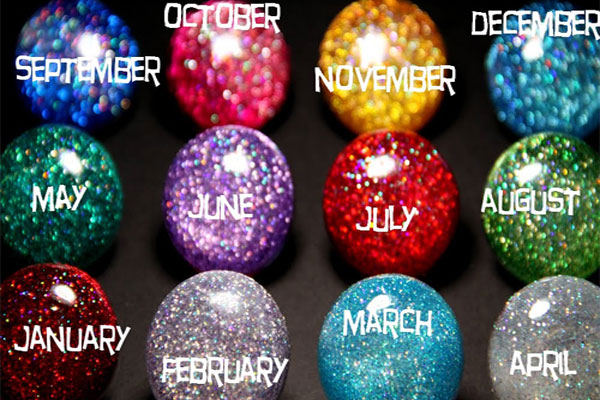What IS your BIRTHSTONE lucky color...
Posted on 01/08/2013 I by: Suruchi

While many jewelry or astrology enthusiasts are familiar with the types of stones that corresponds to their birth months, they are not aware that a lot of these stones also come in different colors. If you always avoided wearing a birthstone because the color was undesirable, you might find yourself pleasantly surprised at the available options.
January: garnet
Garnets naturally come in all colors besides the well-known burgundy, except for blue. Its name comes from the Latin definition for pomegranate. The types of garnets that occur in other colors have different names. Some of the more popular ones include hessonite (yellow-brown to brilliant yellow), rhodolite (reddish lavender and different shades of pink) and spessartite (orange).
February: amethyst
Amethyst is a type of quartz that occurs naturally in shades of light lavender to dark purple. In crystal form, you will find red and gray as well. In gemstone jewelry, the darkest violet hues are more valuable. While the dark shades can occur naturally, dealers often treat amethyst with heat to achieve desirable dark colors, but are supposed to disclose this fact.
March: bloodstone and aquamarine
Despite its unappealing name, the bloodstone is quite attractive. It is a dark-green chalcedony with red spots that give the stone its name. However, smaller gems exist without the red spots. If the bloodstone still holds no appeal, the blue-green to deep-blue aquamarine is an accepted birthstone for March as well.
April: diamond/clear gems
The most popular and traditional birthstone for April is a diamond. However, if it's not your best friend, you may substitute white sapphires, topaz or beryl (goshenite). The term white is a little misleading, as all these are clear stones that make viable options for the April birthstone color.
May: emerald
Emerald is a type of beryl that comes in a variety of greens. Higher quality emeralds have blue undertones, while lighter yellow greens are less expensive. Most emeralds receive a treatment called oiling to seal naturally occurring cracks. Since oiling is very common, sellers do not have to reveal this fact.
June: alexandrite
Naturally occurring alexandrite is a form of chrysoberyl and is one of the rarest gemstones. In daylight, they look green, but change to a purple/reddish color by candle or lamp light.
July: ruby
Ruby falls under the corundum category because it is related to sapphire. Any corundum that is not red is called a sapphire. A rich red color denotes high value; however, if this is too vibrant, you can find them with pink, brown, orange and purple hues.
August: sardonyx
Sardonyx is also known as banded agate or chalcedony. Think of it as a red and brown striped onyx. While this earthy gem is a common stone, it was once more precious than sapphires and gold.
September: sapphire
Sapphires, like rubies, fall under the corundum mineral species and come in all colors except for red (red ones are rubies). Popular variations include yellow, green, pink and purple. That is good news for September babies who for some reason never liked blue or simply crave more variety.
October: tourmaline
October babies quite possibly have the most variety of colors available because tourmalines come in many colors. Their names differ according to color. For example, indicolite is blue, rubellite is reddish purple, schorl is black and verdelite is green. In addition, tourmaline comes in different shades within the same color spectrum. One example is blue tourmaline, which includes any shades from neon-blue to blueish black.
November: citrine
Citrine is a yellowish type of quartz that comes also in orange, reddish brown and dark orange brown. Long ago it was thought to ward off evil thoughts and snake venom. Today this gem is thought to relate to prosperity and success. Regardless, it is very popular, as it is affordable and attractive to many.
December: zircon
Zircon is often confused with cubic circonia, but cubic circonia is a man-made stone, while zircon occurs naturally. Since blue zircon seems most popular, wearers often think that only blue is the birthstone color for December. However, zircon also comes in brown, dark red, orange, yellow and green.

